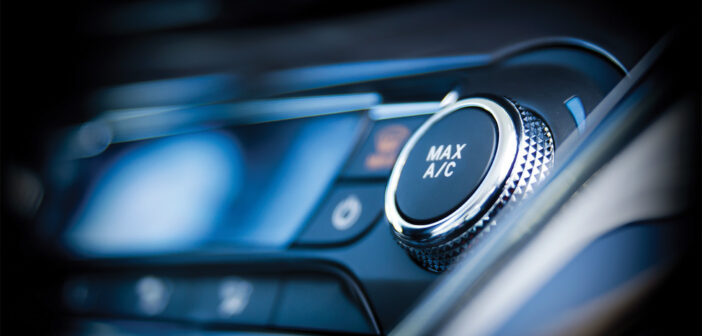Dr. Mihai Burzo, Associate Professor of Engineering at UM-Flint, is interested in heat transfer and human physiological response. For over eight years at UM-Flint and now at its new College of Innovation and Technology, he has been conducting research on thermoreflectance (thermal behavior of microelectronic devices) and human response to external stimuli. Analyzing data drawn from human physiological changes (heart rate, skin temperature, skin response such as sweating, etc.) gathered from multiple sensors and camera arrays, Dr. Burzo has been able to analyze and predict stress levels, driver awareness, deception and thermal discomfort. As a result of his research, Dr. Burzo has recently been awarded a patent for climate control technology that could revolutionize the way the world heats and cools its private and common areas for the comfort of its people and conservation of energy.
“You should never have to manually adjust the thermostat.”
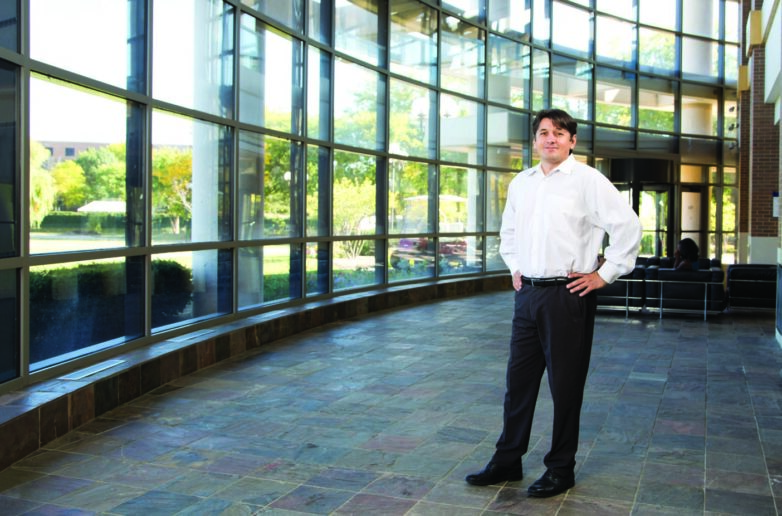
Dr. Burzo has recently been awarded a patent for climate control technology that could revolutionize the way the world heats and cools its private and common areas. | U-M flint faculty staff portrait on Sept. 10, 2013. Mihai Burzo, CSEP.
The patent titled “Multimodal Sensing of Thermal Comfort for Adaptable Climate Control” is the next step in so-called “SMART” technology. “We looked at existing systems and found that they weren’t very smart,” he says. “They still needed to be adjusted by hand and were energy inefficient. This goes further. Our system adjusts automatically to keep an occupant comfortable at all times. You should never have to manually adjust the thermostat.”
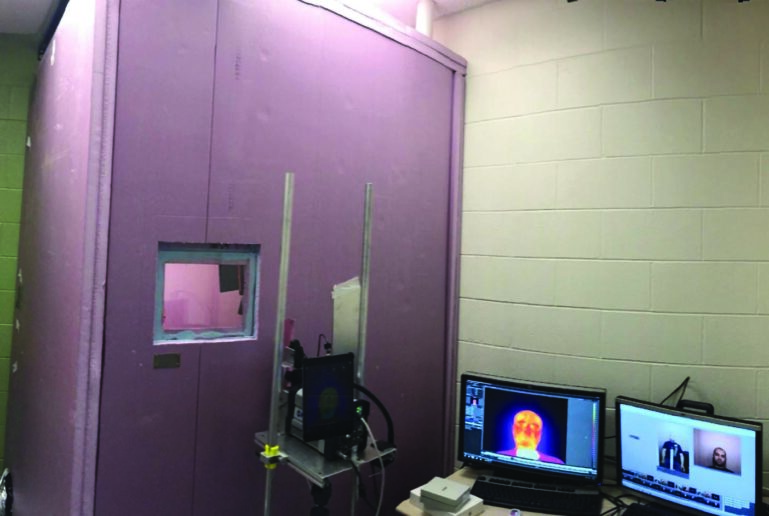
Dr. Burzo and students designed a specialized temperature-controlled chamber where they can vary the temperature inside while measuring a participant’s physiological response.
Using a combination of Artificial Intelligence (AI) and an array of sensors including thermal cameras, light cameras and bio-sensors, Dr. Burzo’s climate control technology will adapt automatically to keep a person at optimal thermal comfort while at work in their home or office building, or while traveling via car. In other words, AI will predict a person’s discomfort based on certain body signals and adjust the temperature accordingly. You should never feel too hot or too cold for too long. “AI is a key component,” says Dr. Burzo. “Models are getting better and better now. It’s not a dangerous thing. It’s just a tool that we can use.”
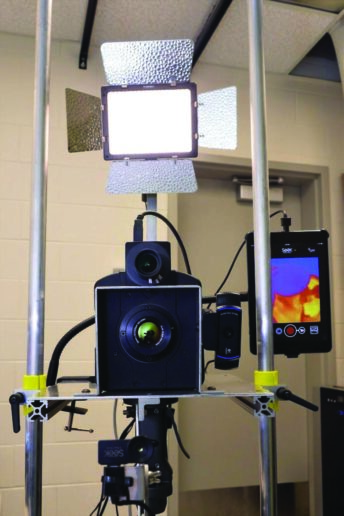 For clarification of application, Dr. Burzo is working with multiple car companies to integrate his technology for optimal driver comfort. Sensors located in steering wheels, car seats, or small thermal cameras can provide AI with the information it needs to keep the cabin at the best temperature for its occupants, saving energy loss from excessive use of air conditioning or heat. “One goal is to make use of the minimum number of sensors possible,” he adds. Imagine getting into your vehicle while wearing a thick coat in winter. At first, you may crank up the heat but after a certain time you may begin to sweat and have to adjust. In a vehicle equipped with Dr. Burzo’s technology, you will never have to touch the climate control at all. The adjustments are made for you. Little energy is lost and you will be in perfect comfort for the duration of your journey. This will be the same for home or public office. “For office buildings, the goal is to make 80 percent of the occupants as comfortable as possible,” Dr. Burzo states. “If a person is not in the room, an adjustment is automatically made, cutting down the unnecessary loss of energy.”
For clarification of application, Dr. Burzo is working with multiple car companies to integrate his technology for optimal driver comfort. Sensors located in steering wheels, car seats, or small thermal cameras can provide AI with the information it needs to keep the cabin at the best temperature for its occupants, saving energy loss from excessive use of air conditioning or heat. “One goal is to make use of the minimum number of sensors possible,” he adds. Imagine getting into your vehicle while wearing a thick coat in winter. At first, you may crank up the heat but after a certain time you may begin to sweat and have to adjust. In a vehicle equipped with Dr. Burzo’s technology, you will never have to touch the climate control at all. The adjustments are made for you. Little energy is lost and you will be in perfect comfort for the duration of your journey. This will be the same for home or public office. “For office buildings, the goal is to make 80 percent of the occupants as comfortable as possible,” Dr. Burzo states. “If a person is not in the room, an adjustment is automatically made, cutting down the unnecessary loss of energy.”
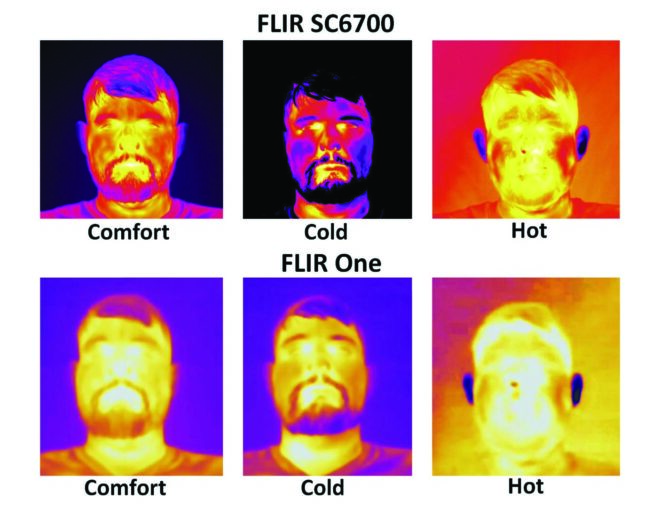
In the future, Dr. Burzo has plans to adapt his technology for the improvement of ventilation systems.
“The UM-Flint students are eager to learn and be involved with what we do. They are very hands-on.”
Interest in heat and energy conservation started for Dr. Burzo while he worked as an assistant professor at the University of North Texas. “I was able to conduct research using the University’s Net Zero Energy Building,” he explains. “It got me thinking about how we can save energy.” He then began adapting his research to include climate control. When he came to UM-Flint in 2013, he continued his work including local students. Dr. Burzo and students designed a specialized temperature-controlled chamber where they can vary the temperature inside while measuring a participant’s physiological response. The data recorded was used to develop an AI algorithm for pattern recognition and climate adjustment. Human participants in the study included UM-Flint students, staff and community members. Research is ongoing. “We are looking for more human participants including the elderly, children and babies,” says Dr. Burzo.
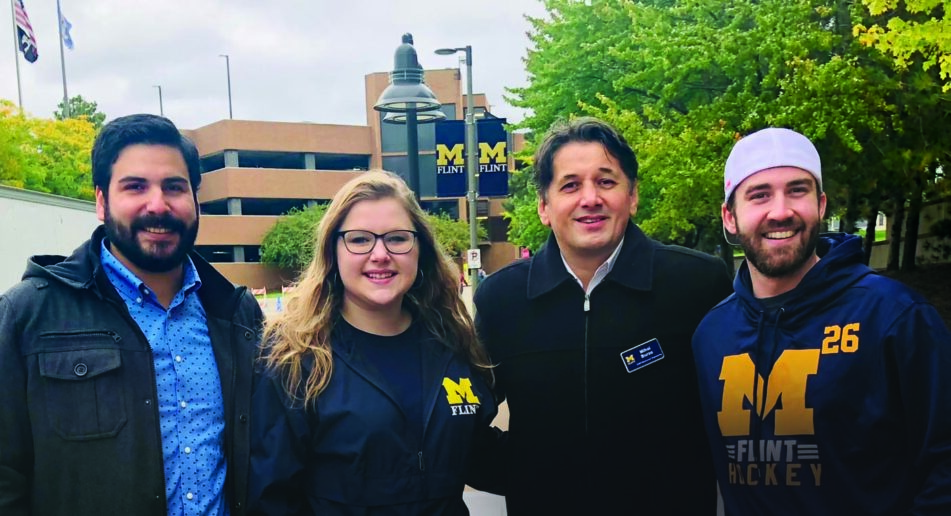
Through his research, Dr. Burzo has worked closely with the students at UM-Flint and attributes much of his success to their help and hard work. “The students here are eager to learn and be involved with what we do,” he says. “They are very hands-on.”
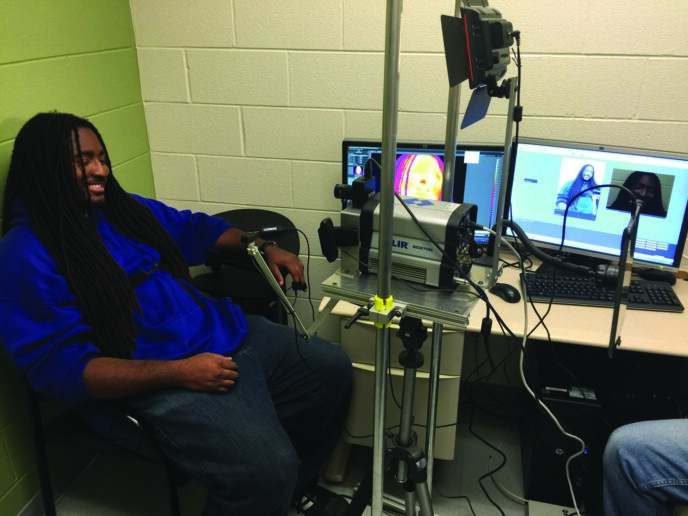
UM-Flint student and project participant Maaliek tests the apparatus.
Energy use and climate control become more and more important every day and it is with hope that Dr. Burzo’s work can make a positive impact in years to come. He hopes to work something out with car manufacturers soon to get his technology operating for consumers in their everyday lives. “Technology moves quickly and we need to also move quickly,” he says. “I hope to see it in operation in a couple of years.”

